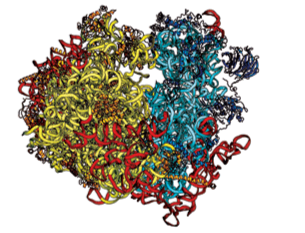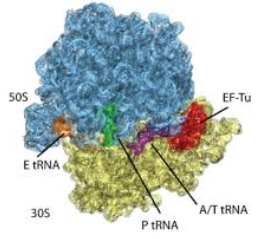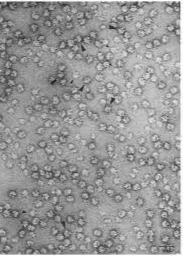George Palade discovered granular, macromolecular structures in animal cells. These macromolecular machines were later christened ribosomes.
Ribosomes: An overview
Ribosomes are macromolecular structures present within all cells. The main function of ribosomes is the synthesis of proteins within the cell. George Palade first observed ribosomes using an electron microscope and described them as dense, granular entities. Proteins are essential for the functioning of any biological cell. Even ribosomes require proteins for the further synthesis of more proteins. Ribosomes are essentially made up of RNA and proteins that facilitate the joining together of amino acid molecules for the formation of long-chain peptides i.e., proteins.
Structure
Ribosomes are divided into two components- a large subunit and a small subunit. The structure of ribosomes can be elucidated as follows-
- Each ribosome is composed of ribosomal RNA and distinct proteins that vary from organism to organism.
- The two ribosomal subunits are of different sizes, attributing to the disproportionate length of the ribosomal axis.
- The (30S) or the small subunit mainly decodes the DNA sequence that is responsible for the encoding of amino acids of a particular protein. It is bound to mRNA.
- The (50S) or large subunit is responsible for catalysis and is bound to tRNA strands that are aminoacylated.
It is important to note that the ribosomal structure is very similar in bacteria, archaebacteria and eukaryotes. They are organized into distinct tertiary structures or motifs such as pseudoknots in which coaxial stacking is observed. However, they do differ along the following lines-
- Size
- Structure
- The ratio of protein to RNA
It is this difference in the ribosomal structure among eukaryotes and bacteria that allows antibiotics to take over the ribosomal machinery of specific bacteria without affecting the ribosomes present in human cells.

Functioning
Ribosomes are responsible for the synthesis of proteins within biological cells. The RNA and associated proteins present within a ribosome are employed for the decoding of genetic sequences, and subsequent peptide bond formation. Ribosomes are either found floating freely within the cytoplasm or can be found attached to the Endoplasmic Reticulum (RER). The primary functions of ribosomes are as follows-
- Decoding of genetic codes into associated amino acid sequences.
- Conversion of amino acid monomers into protein polymers.
- Ribosomes act as catalysts in two significant cellular processes- peptidyl transfer and peptidyl hydrolysis.
To summarize, ribosomes traverse each codon provided by mRNA and subsequently pair each codon with its associated amino acid. These amino acids are provided by aminoacyl tRNA. Due to the utilization of conformational changes by ribosomes, tRNA can be recognized efficiently and accurately.

Ribosomal locations
Based on their location within the cell, ribosomes can be categorised as either “free” or “membrane-bound”. Both types of ribosomes are identical in structure and differ only in the context of spatial distribution. Due to the absence of a phospholipid membrane around ribosome granules, they are often referred to as non-membranous organelles.
- Free ribosomes- these ribosomes are allowed to move freely within the cell cytosol and are barred only from the nucleus and cell organelles. Proteins containing disulfide bonds cannot be synthesized by free ribosomes, due to the reducing nature of the cell cytosol.
- Membrane-bound ribosomes- are found in association with the endoplasmic reticulum. These ribosomes synthesise proteins that are transported within the cell via the secretory pathway. They usually become membrane-bound during the process of protein synthesis. These proteins are often used within the cell or expelled outside via the process of exocytosis.

Biogenesis of ribosomes
The process of ribosome synthesis is different in prokaryotic and eukaryotic cells.
- Prokaryotes- ribosomes are synthesised in the cytoplasm through the transcription of multiple ribosomal gene operons present within the cell.
- Eukaryotes- the process of ribosomal cell synthesis takes place within both, the cell cytoplasm and the nucleolus.
The process of ribosomal synthesis is a result of the coordinated functioning of more than 200 proteins and the processing of the four types of rRNA.

Origin of ribosomes
Studies suggest that ancient ribosomes existed when the only biological molecules available were RNA. These entities could have been self-replicating in nature and then subsequently developed the ability to synthesise proteins once amino acids started being environmentally synthesised. Studies have hypothesised the existence of cells with self-replicating properties that possessed only RNA. These cells are called ribocytes.
Conclusion
Ribosomes are granular entities that are present within all biological cells. These ribosomes are responsible for the decoding of DNA sequences that code for amino acids and the synthesis of peptide bonds. In the context of composition, ribosomes are heterogeneous entities. This heterogeneity is observed not only across different cellular species but also within a single cell. This heterogeneity of ribosomes can be exemplified by observing the compositional differences between cytoplasmic ribosomes and mitochondrial ribosomes in a eukaryotic cell.
14/06/2022







This is a great, inspiring article. I am pretty pleased with your good work. You provided really helpful information. ios-15.com
I don’t think the title of your article matches the content lol. Just kidding, mainly because I had some doubts after reading the article.
For the reason that the admin of this web page is working,
no question very soon it will be famous, due to its quality contents.
I constantly spent my half an hour to read this website’s articles every day
along with a mug of coffee.
It’s great that you are getting ideas from this post as well as from our discussion made at this time.
Hi my family member! I want to say that this article is awesome, nice written and come with approximately all important
infos. I’d like to see extra posts like this .
Heya just wanted to give you a quick heads up and
let you know a few of the pictures aren’t loading properly.
I’m not sure why but I think its a linking issue. I’ve tried it in two different internet browsers and both show the same
results.
Thanks , I have just been searching for information approximately this topic for ages and
yours is the best I have came upon so far. But, what in regards to the bottom line?
Are you sure concerning the source?
Great goods from you, man. I’ve understand your stuff previous to and
you are just extremely wonderful. I actually like what you
have acquired here, really like what you’re saying and the way
in which you say it. You make it entertaining and
you still care for to keep it sensible. I can not wait to read much more from
you. This is actually a wonderful site.
pin up az?rbaycan: pin-up kazino – pin up yukle
mexican border pharmacies shipping to usa mexican northern doctors mexican drugstore online
best online pharmacies in mexico mexican pharmacy northern doctors buying prescription drugs in mexico online
mexico drug stores pharmacies mexican pharmacy northern doctors buying prescription drugs in mexico
best online pharmacies in mexico: Mexico pharmacy that ship to usa – mexican online pharmacies prescription drugs
https://northern-doctors.org/# pharmacies in mexico that ship to usa
mexican border pharmacies shipping to usa: mexican northern doctors – mexican border pharmacies shipping to usa
purple pharmacy mexico price list mexican northern doctors mexico drug stores pharmacies
https://northern-doctors.org/# purple pharmacy mexico price list
reputable mexican pharmacies online: northern doctors – mexican rx online
https://northern-doctors.org/# medication from mexico pharmacy
buying prescription drugs in mexico online: mexican pharmacy – mexico pharmacies prescription drugs
https://northern-doctors.org/# purple pharmacy mexico price list
mexico drug stores pharmacies: northern doctors pharmacy – medicine in mexico pharmacies
https://northern-doctors.org/# buying prescription drugs in mexico
mexican online pharmacies prescription drugs mexican mail order pharmacies mexico drug stores pharmacies
best online pharmacies in mexico: Mexico pharmacy that ship to usa – best online pharmacies in mexico
http://northern-doctors.org/# purple pharmacy mexico price list
mexican drugstore online: Mexico pharmacy that ship to usa – mexico pharmacies prescription drugs
https://northern-doctors.org/# pharmacies in mexico that ship to usa
mexico pharmacy: mexican northern doctors – best online pharmacies in mexico
buying from online mexican pharmacy mexican pharmacy online mexican online pharmacies prescription drugs
mexican border pharmacies shipping to usa: mexican pharmacy online – buying prescription drugs in mexico
buying prescription drugs in mexico online: Mexico pharmacy that ship to usa – mexico pharmacies prescription drugs
https://northern-doctors.org/# mexico drug stores pharmacies
mexican rx online: mexican pharmacy online – buying prescription drugs in mexico
https://northern-doctors.org/# mexican mail order pharmacies
pharmacies in mexico that ship to usa: mexican pharmacy – mexican pharmacy
mexican border pharmacies shipping to usa mexican pharmacy mexican border pharmacies shipping to usa
http://northern-doctors.org/# mexico drug stores pharmacies
mexico pharmacy: reputable mexican pharmacies online – buying prescription drugs in mexico
http://cmqpharma.com/# purple pharmacy mexico price list
mexican mail order pharmacies
reputable mexican pharmacies online: cmqpharma.com – mexican border pharmacies shipping to usa
mexican pharmaceuticals online mexican pharmacy online pharmacies in mexico that ship to usa
reputable mexican pharmacies online
https://cmqpharma.com/# reputable mexican pharmacies online
mexican mail order pharmacies
best online pharmacies in mexico cmq mexican pharmacy online buying prescription drugs in mexico
medicine in mexico pharmacies medicine in mexico pharmacies buying prescription drugs in mexico
reputable mexican pharmacies online cmqpharma.com mexico pharmacy
mexico drug stores pharmacies cmqpharma.com mexico pharmacies prescription drugs
mexico pharmacy mexican pharmacy medication from mexico pharmacy
mexican mail order pharmacies cmqpharma.com buying prescription drugs in mexico online
buying prescription drugs in mexico cmq pharma medicine in mexico pharmacies
https://cmqpharma.com/# mexico pharmacies prescription drugs
mexican pharmaceuticals online
п»їbest mexican online pharmacies mexico drug stores pharmacies mexico pharmacy
indian pharmacy online: mail order pharmacy india – reputable indian pharmacies
best online canadian pharmacy: onlinecanadianpharmacy – best rated canadian pharmacy
https://canadapharmast.com/# my canadian pharmacy
world pharmacy india indian pharmacies safe top 10 pharmacies in india
top online pharmacy india: buy medicines online in india – indian pharmacy
online canadian pharmacy reviews: best canadian online pharmacy – best rated canadian pharmacy
buying prescription drugs in mexico online: buying prescription drugs in mexico – mexico drug stores pharmacies
https://indiapharmast.com/# Online medicine order
mexican mail order pharmacies mexican border pharmacies shipping to usa mexican pharmacy
canadian mail order pharmacy: canadian pharmacy 24h com safe – pharmacy in canada
mexico drug stores pharmacies: medication from mexico pharmacy – mexican drugstore online
pharmacy com canada: canada drugs – best canadian pharmacy to buy from
mexican rx online mexico pharmacy buying prescription drugs in mexico
http://indiapharmast.com/# п»їlegitimate online pharmacies india
india online pharmacy: cheapest online pharmacy india – top online pharmacy india
mexican pharmacy: mexico drug stores pharmacies – mexican rx online
canada drug pharmacy: northwest pharmacy canada – pharmacy rx world canada
http://clomiddelivery.pro/# clomid cheap
https://paxloviddelivery.pro/# paxlovid pharmacy
https://amoxildelivery.pro/# medicine amoxicillin 500mg
http://amoxildelivery.pro/# amoxicillin pills 500 mg
http://doxycyclinedelivery.pro/# no prescription doxycycline
http://ciprodelivery.pro/# purchase cipro
http://doxycyclinedelivery.pro/# doxycycline price south africa
http://doxycyclinedelivery.pro/# cost of doxycycline tablets